Occupational Environment Monitoring at Washing Machine Manufacturing Factory
99,000 ₫
Note: The above price is calculated per sample and may vary depending on the area of the environment to be monitored and market fluctuations. For more accurate pricing support, please refer to the price list or contact our consulting staff directly.
Monitoring the environment of a washing machine production factory is a session for collecting, analyzing, and evaluating workplace factors that may be harmful to workers’ health.
Table of Contents
Toggle1. Overview of the Washing Machine Factory
a. What is a washing machine factory?
A factory for washing machines is a production facility designed to manufacture various types of washing machines. This factory has production lines and processes to fabricate and assemble washing machines from different components and parts.
Washing machine factories usually have quality control departments and lines to ensure that the final product meets quality and performance standards. After inspection and packaging, the washing machines are transported to retail stores or distribution agents for further distribution and sale.

b. Production stages in the washing machine factory
The production stages in a washing machine factory may include the following steps:
- Design and research: The factory’s design and research team develops models and technical drawings for new washing machines. They study features, functions, and technical requirements to ensure the washing machines meet market demand.
- Component manufacturing: Components required to assemble washing machines, such as motors, water pumps, control units, drums, and other parts, are manufactured or purchased from suppliers. These components are usually fabricated in processing plants or ordered from reliable suppliers.
- Assembly: Components are assembled into complete washing machines during the assembly process. Workers use tools and machinery to assemble parts according to specified technical procedures. This stage is crucial to ensure the washing machines are correctly assembled and meet quality requirements.
- Quality inspection: After assembly, parts and functions are inspected for quality. This may include performance testing, durability testing, safety testing, and other functional checks to ensure the washing machine operates correctly and meets quality standards.
- Packaging and transportation: After quality inspection, washing machines are packaged for transport. Packaging includes protective wrapping, cartons, or other protective materials to ensure the machines are not damaged during transport. Then, they are delivered to retail stores or distribution agents for further distribution and sale.

c. Types of machinery used in the washing machine factory
In a washing machine factory, many types of machinery and equipment are used to carry out production and assembly stages. Here are some common machines you might find in such a factory:
- Metalworking machines: Includes metal cutting machines, bending machines, punching machines, and lathes for fabricating metal components such as outer casing, machine frames, or other parts.
- Plastic molding machines: Used to fabricate plastic parts of washing machines, including outer casing, lids, buttons, control panels, and other plastic components.
- Casting machines: Used to shape metal or plastic components by pouring molten material into molds.
- Welding machines: Used to weld metal or plastic parts together, including electronic welding, arc welding, and other welding technologies.
- Lathes and milling machines: Used to process metal components according to turning or milling procedures.
- Pressing and stamping machines: Used to press or stamp metal or plastic parts into desired shapes and sizes.
- Screwdrivers and screw-press machines: Used to assemble parts by screwing and pressing screws into place.
- Quality control and inspection equipment: Includes measuring machines, functional testers, durability testers, and other devices to ensure the quality and performance of washing machines.
- Automation equipment: Includes robotic systems, automated machinery, and controllers to perform assembly or automated operations within the production process.

d. Occupational diseases that workers in the washing machine factory may face
In a washing machine factory, workers may be exposed to certain occupational diseases due to the working environment and production processes. Examples of common occupational diseases in the washing machine industry include:
- Respiratory diseases: Workers may be exposed to dust, chemical fumes, and irritants during production, which can cause respiratory problems such as bronchitis, pneumonia, and allergic reactions.
- Skin diseases: Contact with chemicals such as solvents, detergents, or coatings during production can lead to skin irritation, dermatitis, eczema, and other skin-related issues.
- Hearing-related diseases: Machinery and equipment in the factory can generate high noise levels. Continuous exposure to high noise can cause hearing loss and tinnitus.
- Musculoskeletal injuries: While working with machinery and tools, workers may risk collisions, falls, or injuries during handling of components or tools.
- Stress and fatigue: High-pressure work environments, shift work, and repetitive tasks can cause stress and fatigue for workers.
To ensure workers’ safety and health, washing machine factories typically implement occupational safety measures, provide protective equipment, ensure information and training on labor safety, and comply with regulations and standards regarding occupational health and safety.

e. Popular types of washing machines on the market
On the market, several types of washing machines are commonly produced by leading manufacturers. Some popular types include:
- Front-load washers: This is the most common type on the market, with a horizontal drum and a front-opening door. Front-load washers are generally more water- and energy-efficient and often clean and rinse clothes better.
- Top-load washers: These have a vertical drum and a top-opening lid. Top-load washers are easier to use as you do not need to bend to load or unload clothes, and you can add clothes during the wash cycle.
- Commercial washers: Used in commercial or industrial settings, these washers can handle large loads and are designed for heavy use. They are typically larger and built to withstand continuous operation.
- Washer-dryer combos: Combining washing and drying functions in one unit, these machines save space. Users simply load clothes and wait for the washing and drying cycle to complete.
- Non-water washing machines: A newly developed type that does not use water, instead utilizing technologies like steam, ultrasound, or alternative detergents to clean clothes, promising water and energy savings.

2. Overview of Occupational Environment Monitoring Services
a. What is occupational environment monitoring at washing machine factories?
Occupational environment monitoring (or labor environment assessment) at washing machine factories involves collecting, evaluating, and analyzing measured indicators of occupational environmental factors to implement timely measures that reduce environmental hazards affecting workers’ health and prevent occupational diseases. Occupational environment monitoring is a mandatory requirement for washing machine factories.
Monitoring plays a crucial role in caring for, protecting, and improving workers’ health, as employees are the main human resource of a company and directly generate profit. Workers who are regularly exposed to risks and occupational hazards beyond permitted limits may suffer health impacts and develop occupational diseases.
REGISTER FOR OCCUPATIONAL ENVIRONMENT MONITORING SERVICE
b. Nam Viet’s Occupational Environment Monitoring Program
Nam Viet’s Occupational Environment Monitoring Program is designed by monitoring engineers in the fields of occupational safety and environmental protection. Aimed at ensuring workers’ health and safety, this program employs modern measurement methods to monitor air quality, water quality, microclimate factors, physical factors, dust, and more in the workplace. This program is critical in maintaining a safe working environment and protecting employees’ health.
Additionally, Nam Viet’s program is important for researching and developing new solutions to improve workplace environmental quality. With the dedication and professionalism of the monitoring experts, Nam Viet’s proprietary monitoring program represents a breakthrough in occupational safety management and environmental protection in Vietnam.

c. Standardization in occupational environment measurement procedures
Standardization in Nam Viet’s occupational environment measurement procedures is crucial for ensuring accurate and reliable results. To guarantee accuracy and reliability, the program follows recognized standards and standardized procedures issued by Ho Chi Minh City Department of Health. This ensures that collected data is highly reliable for workplace environment assessment and decision-making regarding workplace improvement to protect workers’ health.
These standardized procedures also ensure that measurements are conducted by highly qualified monitoring specialists with many years of experience, allowing managers and experts to trust results from An Toàn Nam Việt and make accurate, valuable decisions to protect workers and the environment.
By applying standardized measurement procedures, Nam Viet demonstrates its commitment to providing a safe working environment and protecting workers’ health, while contributing to the advancement of occupational safety and environmental management in Vietnam.
d. Reporting results of occupational environment monitoring at washing machine factories
Monitoring results are prepared according to Form No. 04, Appendix III, issued with Decree 44/2016/ND-CP and prepared in two copies: one sent to the labor facility that signed the monitoring contract, and one retained by the monitoring organization.
Monitoring results must be stored indefinitely as required by law.

e. Frequency of occupational environment monitoring according to law
According to Clause 2, Article 18 of the Law on Occupational Safety and Health 84/2015/QH13, employers must organize occupational environment monitoring to assess harmful factors at least once a year.
f. Deadline for submitting occupational environment monitoring reports according to law
The report deadline is before December 31 each year. Enterprises operating factories must submit occupational environment monitoring reports to the Department of Health in the locality where their main office is located and where employees are working.
When there are changes in technology or production processes, or during renovations or upgrades that may generate new harmful factors affecting workers’ health, enterprises must update their occupational hygiene records regarding the harmful factors requiring monitoring.
g. Penalties for violations of occupational environment monitoring for employers
According to Article 27 of Decree No. 12/2022/ND-CP dated January 17, 2022, regulating administrative penalties in labor, social insurance, and Vietnamese workers working abroad under contracts:
- Clause 2: A fine of 2,000,000 – 5,000,000 VND for employers who fail to publicly disclose monitoring results and hazard management at the monitored workplace immediately after obtaining the monitoring and assessment results.
- Clause 3: A fine of 20,000,000 – 40,000,000 VND for employers who fail to conduct occupational environment monitoring to control health hazards as required by law.
- Clause 4: A fine of 40,000,000 – 60,000,000 VND for employers who collude with monitoring organizations to commit fraud in occupational environment monitoring but have not reached the level of criminal liability.
3. Harmful Environmental Factors for Workers in Washing Machine Manufacturing Factories
There are several environmental factors that can be harmful to workers in washing machine manufacturing factories. Here are some examples of potentially harmful environmental factors:
- Dust and chemical fumes: The production process of washing machines can generate dust and chemical fumes from materials such as metal, plastic, and detergents. Long-term exposure to dust and chemical fumes can cause respiratory irritation, pneumonia, and other health problems.
- Noise: Machinery and equipment in washing machine factories often produce high levels of noise during operation. Continuous and loud noise can cause stress, insomnia, and affect workers’ hearing.
- Lighting: Some work areas in washing machine factories may lack natural light and rely on artificial lighting. Insufficient natural light or improper artificial lighting can lead to eye fatigue, visual strain, and impact mental well-being and work performance.
- Temperature and humidity: Certain areas in washing machine factories may have high temperatures and humidity. Excessive heat and humidity can cause fatigue, difficulty breathing, and negatively affect health and work performance.
- Hazardous substances: During washing machine production, harmful chemicals such as solvents, cleaning agents, and coatings may be used. Long-term exposure to these substances can damage the nervous system, endocrine system, skin, and respiratory system.
REGISTER FOR OCCUPATIONAL ENVIRONMENT MONITORING SERVICE
4. Measures to Improve the Working Environment in Washing Machine Manufacturing Factories
To improve the working environment in washing machine factories and ensure workers’ health and safety, the following measures can be applied:
- Ensure ventilation and exhaust systems: Provide an effective ventilation system to remove dust and chemical fumes from the production process. Exhaust systems must be installed and maintained to ensure the factory air is clean and safe.
- Noise control: Apply noise control measures such as soundproofing, acoustic isolation, and ear protection devices to reduce noise to safe levels for workers.
- Improve lighting: Ensure the work environment has sufficient natural light or appropriate artificial lighting. Additionally, provide eye shields or protective glasses to safeguard eyes from intense light.
- Temperature and humidity adjustment: Control temperature and humidity in the factory using air conditioning systems, ventilation fans, and temperature control equipment. This helps create a comfortable and safe working environment.
- Occupational safety training and guidance: Provide comprehensive training on occupational safety, including the use of personal protective equipment, safety procedures, and measures to prevent fires, explosions, and workplace accidents.
- Hazardous substance management: Consider using less harmful or non-toxic alternatives during production. Ensure hazardous substances are stored, used, and disposed of safely according to regulations.
- Regular monitoring and evaluation: Conduct regular inspections, monitoring, and assessments of the work environment to detect issues early and apply necessary corrective measures.
- Periodically conduct occupational environment monitoring in factories, collect and analyze harmful factors affecting workers, and adjust to reduce hazards to prevent occupational diseases.
5. Benefits of Regular Washing Machine Factory Environmental Monitoring
An Toan Nam Viet provides enterprises with excellent benefits when using occupational environment monitoring services in accordance with Decree 44/2016/ND – CP on managing and controlling harmful factors in the workplace affecting workers.
- Enterprises can proactively control harmful factors in workshops or factories.
- Receive advice and recommendations to minimize hazards and improve workplace quality.
- Indirectly protect human resources, the key factor in business development.
- Reduce the impact of occupational diseases on health, lowering future treatment costs.
- Improved worker health ensures product quality and maintains production output.
- Ensure compliance with labor safety laws, avoiding legal risks.
- Enhance credibility and professionalism, elevating the enterprise’s brand.
Nam Viet’s environmental monitoring service is a solution to reduce occupational disease risks, contributing to a clean and high-quality working environment.

6. Nationwide Occupational Environment Monitoring Center
Nam Viet Occupational Environment Monitoring Center is a professional unit specializing in monitoring and measuring occupational environment quality across all provinces in Viet Nam. With a team of experienced monitoring specialists, the center uses modern measuring equipment to ensure accuracy and reliability.
In addition to monitoring services, the center supports clients in planning, handling, and tracking occupational environment issues. With the motto “customer-centric,” the center prioritizes client satisfaction, meets all client needs, and commits to providing the best solutions for enterprises.
REGISTER FOR OCCUPATIONAL ENVIRONMENT MONITORING SERVICE
With investment in technology, equipment, and personnel, Nam Viet’s monitoring center has become one of the most reputable units in occupational environment monitoring in Ho Chi Minh City, with the following objectives:
- We always value our brand reputation and the quality of our services.
- We provide clients with the best and most suitable solutions.
- With a team of experienced Masters and Engineers, committed to protecting the environment and benefiting enterprises.
- Clients using Nam Viet Environmental Monitoring receive professional service from experts, along with the best cost advantages.
The occupational environment monitoring process at Nam Viet includes the following steps:
- Before monitoring, we ensure all equipment is calibrated and meets legal requirements.
- Follow the occupational environment monitoring procedures as committed to the Department of Health.
- Accurately report monitoring results to employers.
- If monitoring results indicate unsafe conditions for workers, Nam Viet will assist in corrective measures, and the enterprise will:
- Implement measures to improve working conditions and minimize harmful factor impacts, preventing occupational diseases.
- Organize health check-ups to detect occupational and related diseases early for workers in unsafe environments.
- Provide compensation in kind for workers according to labor law regulations.

7. Occupational Environment Monitoring Price List
To help enterprises conduct professional and effective occupational environment monitoring, Nam Viet provides clients with a detailed price list for monitoring services that is high-quality and reasonably priced.
- Our price list provides detailed information about monitoring service costs, including transportation, measurement, analysis, and report preparation. Clients can trust the accuracy and reliability of our monitoring reports.
- We commit to offering competitive and reasonable prices while providing prompt and professional consultation for any monitoring service inquiries.
- With Nam Viet’s price list, clients can easily select service packages that suit their needs, ensuring maximum satisfaction with professional service quality.
No comments yet

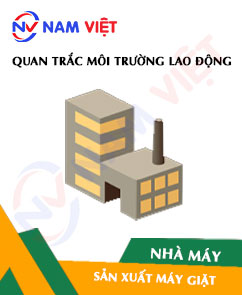
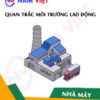
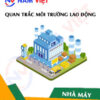

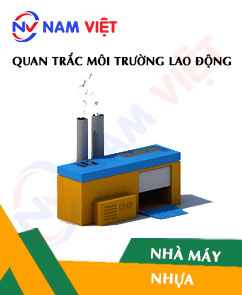
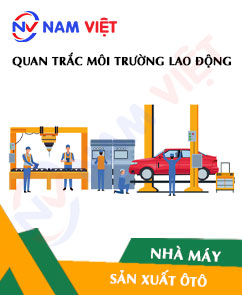




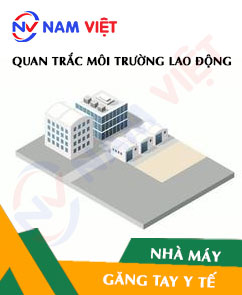
Review Occupational Environment Monitoring at Washing Machine Manufacturing Factory
There are no reviews yet.